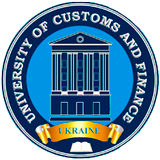CONSTRUCTION OF AN ECONOMIC AND MATHEMATICAL MODEL OF THE NUMBER OF FORMED CUSTOMS DOCUMENTS BASED ON PREVIOUS STATISTICAL DATA
Abstract
The modern state policy of Ukraine in the field of customs affairs is aimed at developing the national economy and integrating it into the world economy. In order to ensure the national interests of Ukraine, foreign trade is constantly monitored and regulated. The Cabinet of Ministers of Ukraine approved the list of documents required for customs control and customs clearance of goods and vehicles moving across the customs border of Ukraine. The State Customs Service of Ukraine constantly collects, stores, processes, analyzes, protects, and distributes official statistical information about goods that move across the customs border of Ukraine. In this paper, an economic-mathematical model of the number of issued customs documents was built on the basis of statistical data on issued customs documents using the methods of correlation-regression analysis using the Microsoft Excel spreadsheet. Modeling is an important tool in customs affairs, which helps to identify, summarize and analyze the characteristics important for foreign trade. Modeling is particularly important for the State Customs Service of Ukraine, as it makes it possible to study foreign trade without conducting experiments. An important prerequisite for qualitative analysis and forecasting is the correct statement of the problem, the correct application of the mathematical apparatus, and compliance with statistical research methodology. The paper investigated the reliability of the obtained results and proved the reliability of the constructed regression function. The resulting regression model makes it possible to forecast the volume of issued customs documents for 2023. The results of this study play an important applied role in planning the volume of foreign and domestic trade in goods in Ukraine for 2023.
References
2. Митна справа : підручник / А. І. Крисоватий, С. Д. Герчаківський, О. Б. Дем’янюк та ін. ; за ред. А. І. Крисоватого. Тернопіль : ВПЦ «Екон. думка ТНЕУ», 2014. 540 с.
3. Наконечний С.І., Терещенко Т.О., Романюк Т.П. Економетрія : підручник. Київ : КНЕУ, 2004. 520 с.
4. Майбородіна Н.В. Економетрика: навчальний посібник. Ніжин : ПП Лисенко М.М., 2021. 280 с.
5. Свічкарь В. А. Особливості митного регулювання в національних та глобальних логістичних мережах поставок. Ефективна економіка. 2018. № 1. URL: http://www.economy.nayka.com.ua/?op=1&z=6065 (дата звернення: 27.04.2023)
6. Спрощення процедур торгівлі в Україні: Митні процедури, проблеми та очікування бізнесу піл час війни. ГО «Інститут економічних досліджень та політичних консультацій». Київ : 2023. 48с.
7. Статистика та реєстри. Статистика декларування, переміщення товарів та транспортних засобів. URL: https://customs.gov.ua/statistika-ta-reiestri
8. Запорожець О. Ф. Адміністрування митних платежів: аналіз та прогнозування надходжень до державного бюджету. Вісник міжнародного державного університету. 2012. № 8. С. 78−89.
9. Васильків І.М. Основи теорії ймовірностей і математичної статистики : навч. посібник. Львів : ЛНУ імені Івана Франка, 2020. 184 с.
10. Лебідь В. В., Мейш Ю. А., Майбородіна Н. В., Герасименко В. П. Застосування методів математичної статистики до прогнозування кількості оформлення митних декларацій. Системи та технології / (правонаступник наукового журналу «Вісник Академії митної служби України. Серія: «Технічні науки». № 2 (64), 2022. С. 30−37.

 ISSN
ISSN 




